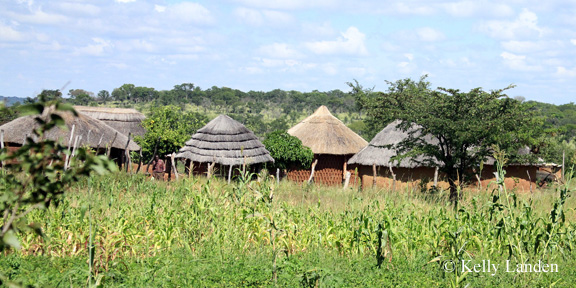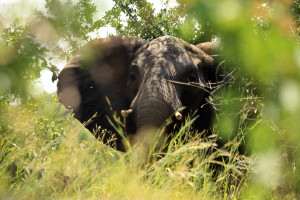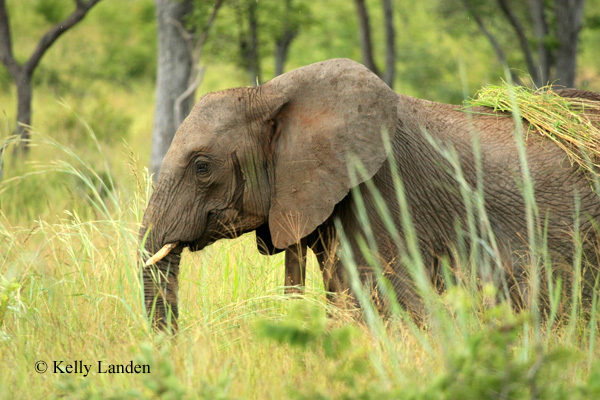Tracking Mary
Mary is the eldest of the once captive, orphan herd of 9 elephants, released late last year in Hwange National Park in Zimbabwe. The herd consists of 8 female, and one young bull, all of which were estimated to be no older than 20 years of age. EWB agreed to collaborate with Wild Horizons Wildlife Trust, based in Victoria Falls, to monitor the herd’s movements as they adjusted back into a free and wild environment. It was decided to deploy a satellite collar on the eldest in the herd when the elephants were released. We have been carefully watching Mary via her satellite collar. (to read more, see http://www.elephantswithoutborders.org/collaborations.php) However, due to the belief that these elephants were once part of 3 different herds, it has been vital for us to seek them out on the ground to visually take notes of their progress and if the herd has adjusted by keeping together as one group. It has been a few months since our collaborative team has seen Mary, and last we found her she was followed by a newborn calf. Recently, we noted that she had made a dramatic movement north, had left Hwange National Park and was now quite close to a rural village area. Concerned, we agreed it was time for us to seek the herd out. Also, despite the rains and thick vegetation, we felt they were now in an area we might be able to actually access.
We headed out early Thurs. morning to pick up a game ranger from Zimbabwe’s Wildlife department to escort us into their jurisdiction in the Matetsi area of northern Zimbabwe. On the drive, I was pleasantly surprised at the beautiful rural homesteads with their well-kept flower gardens and decoratively painted “indlu yomdaka” (Ndebele word for mud houses.) However, I was also taken aback at how large some of the cornfields were in the area. The soils were apparently very rich and the crops were flourishing, unlike what I have seen recently in the Kalahari sands of the Chobe district in Botswana.
The last known satellite position for Mary was only a few kilometers away from some of these homesteads and after talking to a few of the farmers who reported “plenty” of elephants in the area, of course we began to feel concerned. We asked one of the local cattle-herding youngsters that are familiar with the local terrain to help guide us into the forest, as we began VHF tracking Mary to pinpoint her exact location. (How do we track? read: http://www.elephantswithoutborders.org/tracking.php) It didn’t take too long for us to pick up the “ping ping” of her VHF frequency. Unfortunately it was in the direction over a water filled, rocky ravine. So we knew we had to “hoof” it on foot if we were going to actually see her. Grabbing our gear, we headed through the thick, tall grasses in the direction of the signal. I didn’t mind that we were likely to soon encounter wild elephants and who knows what else, face to face, nor the sun’s intensity and heat, nor the “ankle-breaking” rocks we were stumbling over, but after looking at my grass and acacia shrub thorn cut, itchy legs surrounded by sweat attracted bees and biting flies, I certainly did mind that I should’ve had the insight to wear long trousers as opposed to shorts!
Making our way over the ravine, we soon heard the low rumbling of elephants and shaking branches, as they fed. Slowly we worked ourselves around to be on the downward side of the wind and crept closer, now being extra careful to not snap any branches while we walked. Through the tall grasses we could barely make out the massive bodies of elephants up ahead. We tried to scan their backs to take note of the satellite unit on Mary, but we could not identify her.
A large female with a calf detected us, “strangers”, in the brush. She perked her head and ears up as she moved forward to investigate. A few others joined her and made a protective circle around the calf, rumps together, trunks up. We froze, holding our breath for what seemed many minutes, carefully looking around for an escape route, while she decided what to do. Eventually to our relief, she slowly turned, hesitated and strolled off with the others following. We jumped up onto boulders to get a better view and could see that there were many more elephants than the 10 we were seeking. We still had a strong VHF signal, noticing a smaller herd to the left. We hiked to get a better view and sure enough, there Mary stood in plain view!
Quickly we snapped off a few photos and took notes on any significant ear/tusk characteristics to identify each individual. Although the shrub was still thick, we could only count 6 and saw no signs of a calf. As they moved to join the other herd, we followed. All of a sudden, looking behind us came 2 others, following directly on our path. We quickly moved aside to try not to be breaking the herd. They detected us and quickly disappeared. We tried to follow Mary but the herd’s pace was too fast. By the weakening sound of her signal, we knew we could not keep up. We turned and headed back to the vehicle. Disappointed we did not attain enough information from our brief encounter, we decided to keep listening and tracking in case they moved in an accessible direction. Luck was with us and we realized they were following the ridgeline and were closing in towards the sand road. We parked again, jumped out and headed towards the ridge from a different direction. Within a few minutes, we witnessed the entire herd/herds appear from the tree line, walking into the valley, where we now stood. We counted 34 elephants in total. Mary’s small herd kept to the rear, but now we could distinguish that there were 8 amongst them, sadly, no calf. They stopped to graze, unaware of our presence. We were able to sit and watch them for some time. Satisfied with this second sighting, we finally made our way back to rest.
So what did we learn from this excursion? The good news is that we believe that Mary and the other released females are bonded as to being their own herd, now following and bonding with a larger herd. The only bull that was released with the herd may or may not be part of the herd. It was too difficult to tell if he was amongst the others at that point because the elephants were all moving in thick shrub and grass. We were very disappointed to discover that Mary unfortunately has lost her calf. Also, we are concerned over the elephants’ close proximity to people and crops, especially because of the sightings mentioned by the farmers. However on a positive note, throughout our excursion, we examined all the dung piles we came across and saw no evidence of this particular herd crop-raiding. At this point, we view the herd’s adaption back into the wild, a success. And for now, all we can do is carefully watch Mary’s movements and continually check on the herd’s progress. We will be sure to share their continual story with you, as we learn more.
To receive EWB’s updates and newsletters, subscribe at http://elephantswithoutborders.org/phplist/?p=subscribe
To support EWB’s projects, we appreciate your support! http://www.elephantswithoutborders.org/donate.php
Tags: africa, conservation, elephants, elephants without borders, Hwange, people, research, satellite collar, tracking, wildlife, Zimbabwe










